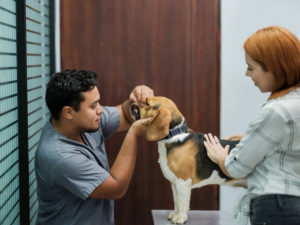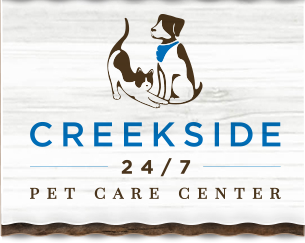Periodontal disease is a bacterial infection that occurs in the mouth. Just as humans can develop problems with their teeth and gums that require dental care, a dog’s teeth also need regular care. Without treatment, serious and life-threatening conditions like kidney failure, diabetes, and heart disease can occur.
What causes Periodontal Disease?
As your pet eats, food remnants and bacteria build up on the outside of the teeth along the gumline. As this bacteria accumulates, it hardens and forms plaque and tarter. When this hard tarter starts pushing the gums away from the teeth, the bacteria can invade the gums and spread into the bones of the jaw and sinuses.
Symptoms of Periodontal Disease
As a responsible pet owner, you should monitor your pet regularly for signs of health issues, including periodontal disease. Examine your pet’s mouth once a week. Look for stains on teeth. The teeth might appear yellowed or have brown staining. A big sign of a problem is bad breath caused by the buildup of bacteria. Adult dogs who have loose or missing teeth may be suffering from periodontal disease.
In addition to visible plaque or problems in the mouth, pets may display behaviors that should alert you to a dental problem. Pets who suddenly stop eating hard, dry food or swallow their food without chewing it properly are probably suffering from pain while eating. Other signs of mouth pain include shaking the head while eating, only eating on one side of the mouth, and awkwardly picking up individual pieces of dry kibble.
Other things you might notice are dried blood around the outside of the mouth, excess drool or saliva, blood residue in the food or water dish, or visible bleeding inside the mouth. Losing permanent teeth is a major sign of a problem.

How is this Disease Treated?
Even if your pet shows signs of periodontal disease, your veterinarian can help remedy the problem. The first step is a thorough examination including xrays of the teeth and gums. This will allow the vet to determine how advanced the disease is. Periodontal disease is graded in stages.
Stage 1: Some plaque buildup is present on the teeth. The gums may be red and inflammed.
Stage 2: X-rays reveal a loss of gum tissue and roots are in danger of exposure. Teeth are discolored and gums and swollen and recede away from the teeth. Loose teeth may occur. Bleeding gums are common. Bad breath is recognized. Pain may cause feeding problems.
Stage 3: Up to 50% loss of gum attachment and root attachment to the jaw bone. X-rays reveal major deterioration and a dental probe can be inserted under the tooth and into the root area. Tooth loss may occur and bad breath is persistent and foul smelling. The animal is experiencing severe pain and may go for long periods without eating.
Stage 4: There is a loss of bone and root attachment greater than 50% and the gums have receded to the point that roots are exposed. Tooth loss and pain are persistent. The pet may refuse to eat kibble and need a soft food diet. The teeth are visibly misshapen by plaque buildup and stained brown. Bad breath is foul and strong, making the animal undesirable.
Treatment Plans:
After determining how advanced the disease is, your veterinarian will schedule an appointment to draw blood from your pet. The purpose of this bloodwork is to check liver and kidney functions, blood sugar levels, and general wellness. Periodontal disease can seriously damage your dog’s organs so these tests are necessary.
Once your veterinarian has determined that your pet is healthy enough, an appointment will be made for teeth cleaning. This involves putting your pet under anesthesia. A breathing tube is inserted and the animal is sedated.
The vet will perform a thorough cleaning, including scaling and planning the roots to remove the accumulation of tarter and plaque from all tooth surfaces. Any residual infected pockets will be drained and filled with antibiotic gel. Any teeth that are too loose at the roots will be extracted. Stitches may be required to close any incisions.
Following the dental procedure, your pet will remain at the office until he is completely awake and in stable condition. The doctor may prescribe oral antibiotics and a soft diet for a week or so.

At-Home Maintenance and Prevention
After the infection is removed and any damaged teeth are removed, your pet will need a short healing period. Once healing is complete, you will need to manage your dog’s dental health at home.
There are special brushes with canine toothpaste available at your vet’s office or local pet retail supplier. You should brush your dog’s teeth at least once per day. You might begin with just an introduction to the toothbrush and paste, but gradually increase the time until you can brush all your dog’s teeth.
If your dog absolutely refuses the toothbrush,you can wipe the surfaces of the teeth with a clean, dry gauze square. While this won’t work as effectively as the toothbrush, it will help control the bacteria.
Other things that help keep a dog’s teeth clean are special food and plenty of chew toys. Ask your veterinarian about an oral health diet for your pet. High quality food will neutralize bad bacteria and the dry kibble will help keep the teeth clean. You can also provide your pet with plenty of textured chew toys that help remove plaque buildup from teeth. These can include rubber balls, bone shaped nylon chewers with bumps, and fabric toys with textured sections.
One thing that is a must after your dog is treated for periodontal disease is continued dental care. Your pet’s doctor may require three or six month check ups for the first year, to be sure the bacteria doesn’t reoccur. Thereafter, dental cleanings should be scheduled annually.
Periodontal disease in pets can be serious and life threatening, but with proper care and treatment it can be healed.
If you have any questions or would like to schedule an appointment, call us at (817) 421-5850. Here at Creekside Pet Care Center, we would be more than happy to answer any questions you may have!






